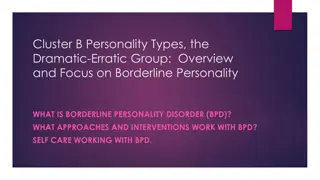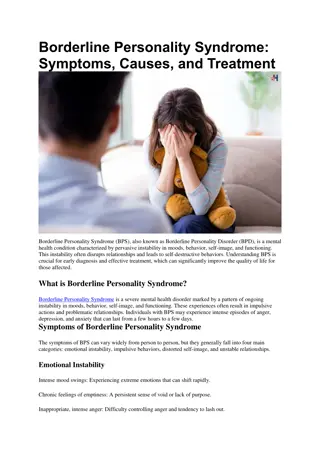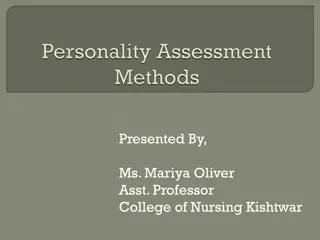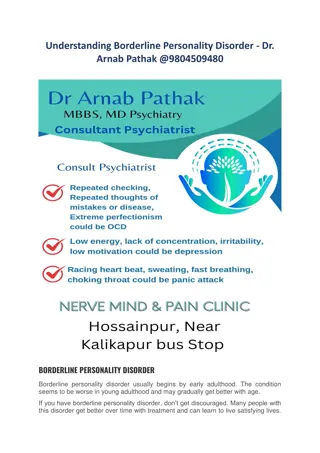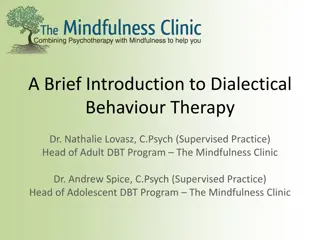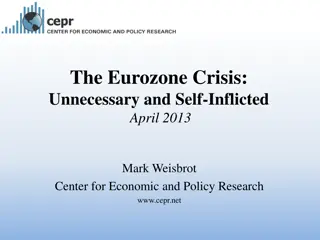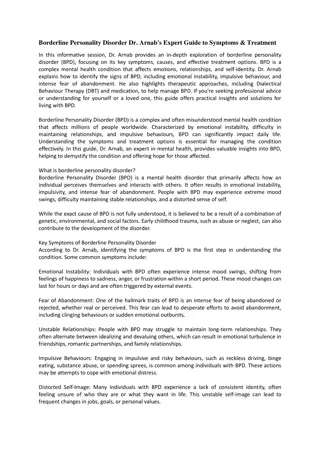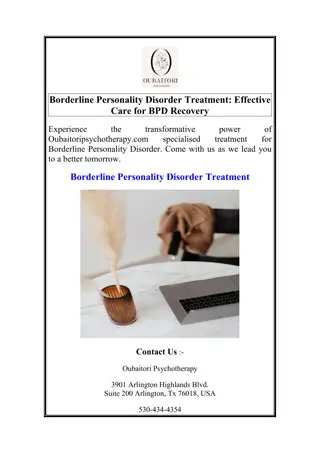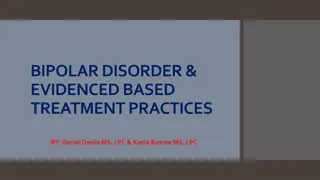Understanding Borderline Personality Disorder (BPD) Crisis Presentations
Borderline Personality Disorder (BPD) is a common and challenging disorder, especially in clinical populations. With prevalence varying from 1-2% in the general population to up to 25% in agitated emergency patients, BPD often presents in crisis situations, leading to suicidal behavior and frequent visits to the Emergency Department. Diagnosis of BPD can evoke strong reactions, with issues of both over and under-diagnosis. Treatment approaches may sometimes oversimplify the complex needs of patients. This discussion delves into recognizing BPD, managing crisis presentations, and effective strategies to treat BPD during crisis episodes.
Download Presentation

Please find below an Image/Link to download the presentation.
The content on the website is provided AS IS for your information and personal use only. It may not be sold, licensed, or shared on other websites without obtaining consent from the author. Download presentation by click this link. If you encounter any issues during the download, it is possible that the publisher has removed the file from their server.
E N D
Presentation Transcript
BPD is common disorder, especially in clinical populations Prevalence 1-2% general population, up to 10-20% outpatients, 25% agitated emergency patients BPD often present in crisis, suicidal and often in ED Challenging to work with
Diagnosis engenders strong reactions Over diagnosed and under diagnosed Black and white approach to treatment Patient s concerns may be dismissed, suicide risk minimized and negative outcomes blamed on patient
Most literature based on intensive outpatient treatments Crisis management strategies usually end with transfer to ED Today s discussion, 3 parts: Diagnosis and recognition of BPD Crisis presentations Strategies to treat BPD in crisis
DSM-IV-TR defines a PD as: enduring subjective experiences and behaviour that deviate from cultural standards, are rigidly pervasive, have an onset in adolescence or early adulthood, are stable through time and lead to unhappiness and impairment.
Borderline between psychosis and neurosis characterized by extremely unstable affect, behaviour, mood, self-image and object relations ICD-10: emotionally unstable PD as-if personality
Abandonment Mood reactivity Stormy relationships Emptiness Identity disturbance Anger/rage Impulsivity Paranoia/dissociation Chronic suicidality
Negative counter transference reaction Manipulation Self-sabotage Help-seeking, help-rejecting pattern Transitional objects, teddy bear sign
Just a negative reaction to a patient A cross-sectional diagnosis A hopeless case
more commonly have childhood histories of physical and sexual abuse, neglect, and early parental loss and separation Frequently co-morbid with other PDs Axis 1: mood disorders, PTSD, SUDs, eating disorders, ADHD, panic disorder, dissociative disorders
Unknown Multifactorial heterogeneous Genetic/neuroanatomy Amygdala/limbic system Serotonin 5HTT transporter gene Heritability inconsistent Dimensional, genetic phenotypes Livesley four factor model Developmental Kernberg object relations Mahler object constancy Bowlby insecure attachments Bipolar variant Recent review (Paris,Gunderson) did not support Complex PTSD Herman
an unstable period a crucial stage or turning point A sudden worsening
frantic effort to avoid abandonment manifests itself in an exaggerated, often maladaptive response Attempt to solicit caring response Present in crisis due to extreme response, instability, affect dysregulation, lack of social supports, trauma history Self harm, suicidality, aggression/anger, intoxication, risky impulsivity, psychosis/dissociation
Loss Abandonment Rejection Financial stress Impulsive behaviour Self-loathing Conflict in relationships Intoxication Being alone Trauma New Re-enactment Triggers
SPLITTING PROJECTIVE IDENTIFICATION Good Object Bad Object
IDEALIZED, GOOD OBJECT DEVALUED, BAD OBJECT Rescuer Wants to help pt Takes over Over advocates Poor boundaries Reinforced by pt. statements such as: you are the only one who has ever understood Dismisser Doesn t listen or empathize Dismisses patient concerns Reacts angrily Challenging, confrontational Gives cookbook , unhelpful suggestions
RESCUER DISMISSER Feeds into splitting Divides team Decreased pt. Responsibility Boundary violations Isolated with pt. Burned out Abandon pt. Escalate pt. Anger Increased suicide risk Pt. Threats, complaints Reject pt.
Interactions can lead to re-enactments of negative, traumatic relationships Interactions can make pt. worse and increase suicide risk Important to be real, caring, set limits, enforce boundaries therapeutic for the patient
8-10% of patients with BPD complete suicide Patients with BPD represent 9-33% of all suicides History of suicidal behaviour in 60-78% of patients with BPD Chronic suicidality with 4 or more visits to psych ED, most often diagnosed with BPD, 12% of all psych ED visits Common co-morbidities increase suicide risk BPD pts. have multiple suicide risk factors
McGirr et al., 2007 BPD suicide associated with higher levels Axis 1 co- morbidity, novelty seeking, hostility, co-morbid PD, lower levels harm avoidance Fewer psych hospitalizations and suicide attempts but increased SUD, cluster B co-morbidity Pompili et al., 2005 Higher rates of suicide in short term vs. Long term follow- up, suggests highest suicide risk in initial phases of illness Links suggests higher risk of suicide in young pts. (adolescence to 3rd decade) Paris suggests higher risk of suicide in late 30s, no active treatment, failed treatment
Zaheer, Links, Liu Psychiatric clinics NA, 2008 RCT, 180 patients, BPD + recurrent suicidal behaviour Prospective trial to assess risk factors of high lethality vs. Low lethality attempters High lethality attempters: older, more children, PTSD, other PD esp. ASPD, specific phobia, anorexia, lower GAF, more childhood abuse, more exp to meds, more hospitalizations, more expectation of fatal outcome Independent variables: exp fatal outcome, schizotypal dim, PTSD, lower GAF, specific phobia, # psych admissions last 4 months suffering chronic illness course with significant psychosocial impairment. These patients may be demonstrating an escalating series of suicide attempts with more and more suicide intention.
Acute on chronic risk Acute stressors and acute risk factors increase acute risk Many BPD pts. meet criteria for Form 1/3 chronically Current Axis 1 co-morbidity, substance use, stressors, lack of protective factors and supports 3 signs that immediately precede pt. Suicide: a precipitating event, intense affective state, changes in behaviour patterns Hendin et al., 2001
Dawson never admit a patient with BPD influential Paris, Linehan recommend against admission Positively reinforcing socially Reinforces suicidal and self-destructive behaviours Regression Sometimes patients admitted due to lack of connection with resources APA Guidelines 2001 Indications for brief hospitalization: Imminent danger to others Serious suicide attempt, loss of control suicidal impulses Psychotic episodes with poor judgement/ poor impulse control Severe unresponsive symptoms interfering with functioning
Patient quote from Williams, 1998 Do not hospitalize a person with BPD for more than 48 hours. My self-destructive episodes one leading right into another came out only after my first and subsequent hospital admissions, after I learned the system was usually obligated to respond....When you as a service provider do not give the expected response to these threats, you ll be accused of not caring. What you are really doing is being cruel to be kind. When my doctor wouldn t hospitalize me, I accused him of not caring if I lived or died. He replied, referring to my cycle of repeated hospitalizations, That s not life. And he was 100% right.
Pascual et al., 2007 11,578 consecutive visits to psych ED BPD diagnosed for 9% (1032 visits), 540 individuals 11% hospitalized suicide risk, danger to others, symptom severity, difficulty with self-care, non- compliance to treatment Pts. with BPD had greater clinical severity, percent hospitalized lower (11 vs 17%)
General Principles: Try to discharge Admit as briefly as possible Overnight in ER or holding beds Keep voluntary Carefully assessed diagnosis essential Care plans Good discharge planning
Triage BPD patients last as long as safely contained in ED Some pts leave before seen Some pts settle, use own resources to manage crisis + reinforcement of positive behaviour, - reinforcement extreme behaviours
Linehan, 1993 Listen to emotional content of sucidality/crisis and validate feelings Identify circumstances leading to feelings Dialogue with pt to develop alternative solutions Livesley, 2005 Safety and managing crises Containment Control and regulation Interventions to reduce self-harming behaviours Controlling and regulating dysphoria Reframing triggering situations
Listen and empathize Validate pt Help pt id emotions Develop rapport Rogers-empathy, non- judgemental, unconditional + regard Get at underlying trigger and emotion Often pt unaware Helps defuse Therapeutic Avoid, proactive Suicide assessment Expression of distress May shift Reassess regularly Acute vs. Chronic Don t dwell on it May reflect escape, control
Relief from emotional pain comes from connection to someone who understands Align with pt s distress and offer support and understanding Weakened by failure to acknowledge distress, lengthy attempts to clarify feelings, interpretations Strategies Praised for seeking help Help pt id strengths Survival skills Put situation into perspective Interpretation Confrontation Clarification Encouragement to Elaborate Empathic Validation Advice and Praise Affirmation
Mobilize supports-family, friends, professionals Stepwise way to approach crisis Follow-up arrangement Caring statements, photographs Can always come back to ED Joint Crisis Plans: pt and are team prepare ahead of time
Reinforce successful adaptive strategies Distraction + self talk Thought stopping Substitution Grounding Journalling/artwork Emotion log/ emotion sheets
AVOID except acutely Dependency Benzodiazepines Antidepressants SSRIs>MAOIs Low mood, anxiety, impulsivity, anger Anger management Safety risks OD, preg Mood stabilizers Helps all symptoms Low dose, prn, ongoing Side effects Typical vs. atypical Antipsychotics
Meds are tools to help with symptom control Meds symptom based vs. generally helpful First do no harm OD potential Pregnancy risk Med dependency/diversion withdrawal Prescriptions for small amounts
Pascual et al, 2008 11,578 consecutive visits to psych ED over 4 years 1032 (9%) visits diagnosed BPD, 540 individuals Prescribe benzos Male sex, anxiety, good self care, few med or drug problems, housing instability Prescribe antipsychotics Male sex, danger to others, psychosis Prescribe antidepressants Depression, little premorbid dysfunction
Damsa et al, 2007 25 pts, severe agitation + BPD Received 10mg im olanzapine Reduced agitation, good tolerance within 2hrs 16% required second dose Pascual et al, 2004 12 BPD pts Received ziprasidone 20mg im then oral ziprasidone 40- 160mg/day, monitored up to 2 weeks Overall significant improvement, well tolerated
Helpful to give the patient something Follow-up appointment Crisis line number Prescription/meds Voice mail Treatment plan Written note
Beware No medico-legal value Does not replace assessment, treatment plan, documentation Helpful when ongoing therapeutic relationship Sometimes helpful as part of suicide assessment Do not base clinical decisions on contract
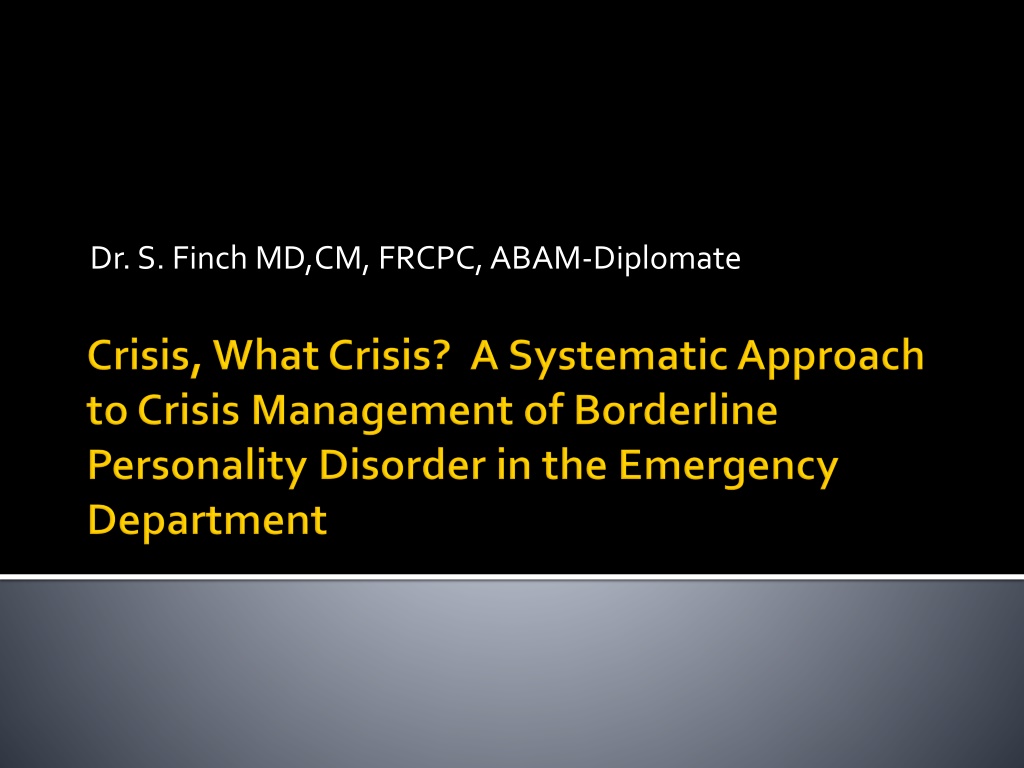
 undefined
undefined













